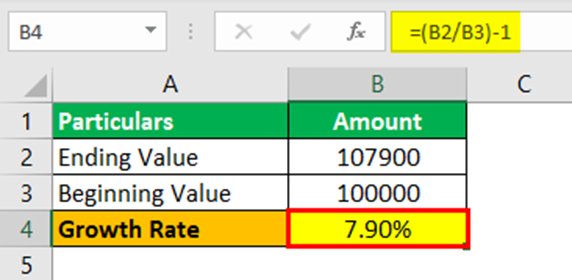The world of entrepreneurship is full of uncertainty and creative success, but the one thing that remains consistent for startups is their growth rate. Being able to accurately measure and track your startup’s progress is an essential part of any successful business. The growth rate is key information that can shape how you make decisions, rethink strategies, and respond to changes in the market. This blog post aims to provide a comprehensive look at what entrepreneurs need to know about growth rates so they can stay ahead of their competition and maximize their potential.
What is The Growth Rate?
The growth rate metric is a measure of the speed at which a company’s business is growing. It shows how quickly revenues, profits, assets, and other financial measures are increasing over time. Growth rate metrics provide valuable insights into the overall performance of an organization as well as its ability to compete in the marketplace.
Growth rates are often used to compare different organizations and evaluate the success of a particular product, service, or business strategy over time. Knowing the growth rate metric is an important tool for investors and business owners alike, as it provides a snapshot of how well a company is doing financially. Why Is It Important For Startups To track the Growth Rate?
Following are the reasons why tracking the growth rate is important for Startups:
1. Helps to measure performance:
Tracking the growth rate helps startups understand their overall performance, as it allows them to track not only their sales figures but also customer engagement and brand awareness. This in turn helps them identify areas of improvement and take corrective measures accordingly.
2. Keeps a check on the competition:
A startup needs to stay competitive in the market. Tracking their growth rate allows them to keep an eye on the competition and measure their performance against that of other players in the industry. This helps them identify areas where they are lagging and what needs to be done in order to bridge the gap.
3. Helps optimize marketing efforts:
A startup can use the growth rate to analyze the effectiveness of its marketing campaigns. They can use insights derived from the tracking to optimize their efforts and maximize returns on investments in terms of leads generated, conversions made, etc.
4. Keeps a check on financial health:
Tracking the growth rate also helps startups measure their financial health and identify any signs of trouble before it’s too late. This helps them to take necessary measures in time and ensure their financial stability.
These are some of the reasons why startups need to track their growth rate. Doing so enables them to measure performance, stay competitive, optimize marketing efforts and keep a check on their financial health.
It also helps them identify areas of improvement and take corrective measures accordingly. This in turn helps them stay on track and grow their business in the long run.
How To Calculate the Growth Rate?
Here is the formula to calculate the Growth Rate:

Example: Let’s say a company has sales of $200,000 in the year 2019 and sales of $250,000 in 2020.
To calculate the growth rate, we would use this formula:
Growth Rate = (250,000/200,000) – 1 = 0.25
So the growth rate for the company is 25%.
This means the company’s sales have seen a growth of 25% from 2019 to 2020.
What factors affect the Growth Rate?
The following factors affect the growth rate:
1. Market Conditions:
For a business to grow, it must take advantage of favorable market conditions. This means understanding what is happening in the industry and analyzing the trends in order to capitalize on opportunities as they arise.
2. Competition:
Businesses need to differentiate themselves from their competitors to succeed and grow. This means monitoring competitors and their strategies as well as developing innovative products and services to stand out from the competition.
3. Leadership:
A business’s success or failure depends on its leadership team. Having a strong, experienced leader who can make strategic decisions and motivate employees is essential for driving growth.
4. Innovation:
To stay ahead of the competition, businesses need to continuously innovate and evolve. This means investing in research and development, staying up-to-date with industry trends, and finding new ways to differentiate their products or services from those of competitors.
5. Risk Taking:
Growth requires taking risks in order to reap rewards. Businesses must be willing to take calculated risks in order to expand their operations and remain competitive.
6. Financial Resources:
Having the right financial resources is essential for businesses to grow. This means having enough capital to invest in new projects, hire additional employees, and purchase necessary equipment or materials.
7. Customer Satisfaction:
Meeting customers’ needs is key when it comes to growing a business. Companies need to focus on customer service, build relationships with customers, and continually improve products or services in order to gain loyalty and trust.
8. Technology:
Staying ahead of the curve when it comes to technology is essential for businesses today. This means investing in the latest software, hardware, and digital marketing tools in order to reach new customers and stay on top of trends.
9. Motivation:
Employees need to be motivated in order to reach their fullest potential, which is essential for the growth of a business. Companies need to create an environment that encourages employee creativity, productivity, and collaboration.
10. Adaptability:
The ability to quickly adapt to change is key when it comes to staying competitive and growing a business. Companies need to be able to identify new opportunities, trends, and threats in order to stay ahead of the competition.
These are just some of the factors that can affect the growth rate. Every business is unique and will require its own strategy for success.
What is a good growth rate in business?
The answer to this question depends on the type of business and its current stage of growth. Generally speaking, a good growth rate for a business is one that exceeds inflation or industry averages. For example, if an industry’s average annual growth rate is 5%, then a good growth rate for a particular business could be 7% or higher.
Additionally, the growth rate should remain consistent, meaning that a business should not experience a rapid drop in sales or revenue one year, then a dramatic spike the next. It is important to ensure that any growth rate is sustainable over time. Small businesses may have different goals and expectations than larger companies, so it’s important to consider all aspects of your particular business before setting a target growth rate.
With proper planning and the right strategy, your business should be able to achieve a healthy and sustainable growth rate.
What are the examples of growth rates?
The growth rate of John Morrison’s $100,000 investment can be calculated by dividing the ending value (107,900) by the beginning value (100,000) and subtracting 1. The result is a growth rate of 7.9%. Therefore, his money has grown by 7.9% over the year. Growth Rate = (Ending Value / Beginning Value) – 1

Therefore, the growth rate of John Morrison’s $100,000 investment can be calculated as: Growth Rate = (107,900/100,000) – 1 = 7.9%.
Example 2:
Let’s consider that we are calculating the growth rate of the U.S. population. To calculate the year-over-year (YoY) growth of the US population from 2000 to 2021, we can divide each year’s population by that of the preceding year.
For example, in 2001 the YoY growth was 0.99%, calculated as 284,968,955 divided by 282,162,411, minus one. The YoY growth rates for each year are: 2000 → 2001 = 0.99%, 2001 → 2002 = 0.93%, 2002 → 2003 = 0.86%, 2003 → 2004 = 0.93%, 2004 → 2005 = 0.93%, 2005 → 2006 = 0.97%, 2006 → 2007 = 0.96%, 2007 → 2008 = 0.95%, 2008 → 2009 = 0.88%, 2009 → 2010 = 0.83%, 2010 → 2011 = 0.73%, 2011 → 2012 = 0.74%, 2012 → 2013 = 0.70%, 2013 → 2014 = 0.74%, 2014 → 2015 = 0.74%, 2015 → 2016 = 0.73%, 2016 → 2017 = 0.63%, 2017 → 2018 = 0.53%, 2018 → 2019 = 0.46%, 2019 → 2020 = 0.35%, and 2020 → 2021 = 0.73%.
To calculate the Compound Annual Growth Rate (CAGR), we will use the parameters of 21 years, a beginning population of 282,162,411, and an ending population of 331,893,745. The CAGR comes out to 0.78%, calculated as (331,893,745 ÷ 282,162,411) ^ (1 ÷ 21 Years) – 1 = 0.78%.

Thus it can be seen that the US population has grown at an average of 0.78% per year from 2000 to 2021.
Tips to improve the growth rate
following strategies can help to improve the growth rate:
1. Develop a Strategic Plan:
Having a strategic plan is essential for setting and achieving growth goals. Developing an effective strategy to guide your business forward can help identify the steps necessary to achieve desired outcomes and ensure success in the long run.
2. Focus on Customer Satisfaction:
It’s important to focus on customer satisfaction to ensure repeat business and drive growth. Focus on providing quality products and services, as well as excellent customer service.
3. Invest in Marketing:
A solid marketing plan is essential for driving leads, sales, and ultimately growth. Investing in the right marketing channels can help attract new customers and generate more revenue for your business.
4. Keep Your Costs Low:
Keeping costs low is an essential part of driving growth. Strive to eliminate wasteful spending and prioritize investments that can help drive sales and maximize profits.
5. Take Advantage of Technology:
Utilizing the right technology can help streamline processes and optimize operations, helping you save time and money while also allowing you to grow faster.
6. Utilize Automation:
Automating certain processes, such as marketing and customer service, can help free up time for employees and allow them to focus on more productive tasks. It can also reduce labor costs and help improve productivity.
7. Adapt Quickly:
A key element of success is the ability to adapt quickly. Staying on top of industry trends and taking advantage of new opportunities can help drive growth. Additionally, it’s important to respond quickly to customer feedback to make sure their needs are met.
8. Take Risks:
While it’s important to be cautious, taking some risks can help drive growth. Whether it’s investing in new technology or launching a new product, taking calculated risks can help your business expand and reach new heights.
9. Measure Progress:
Measuring progress is an important part of managing growth. Develop key performance indicators that track important metrics such as revenue, customer satisfaction, and employee productivity. Tracking these metrics will help you stay on top of your progress and make necessary adjustments accordingly.
10. Hire the Right People:
Having the right team in place is essential for driving growth. Prioritize hiring people with the skills and experience needed to help your business reach its goals. Additionally, focus on building a culture of collaboration and innovation to ensure that everyone is working towards the same goals.
Following these strategies can help improve the growth rate of your business.
The bottom line
A startup’s growth rate is important for a variety of reasons. Not only does it give you an idea of how quickly your company is growing, but it can also help you attract investors and gauge your progress against similar companies.
There are a few things to keep in mind when it comes to growth rates. First, make sure you are comparing apples to apples. Second, don’t let your vanity metrics deceive you- focus on the right numbers. Finally, remember that every business is different and there is no magic number for what growth rate startups should aim for. Keep these things in mind and you will be well on your way to impressing potential investors with your strong growth rate!

